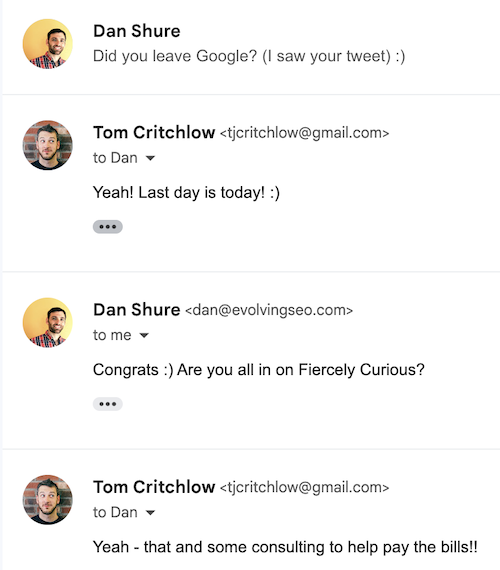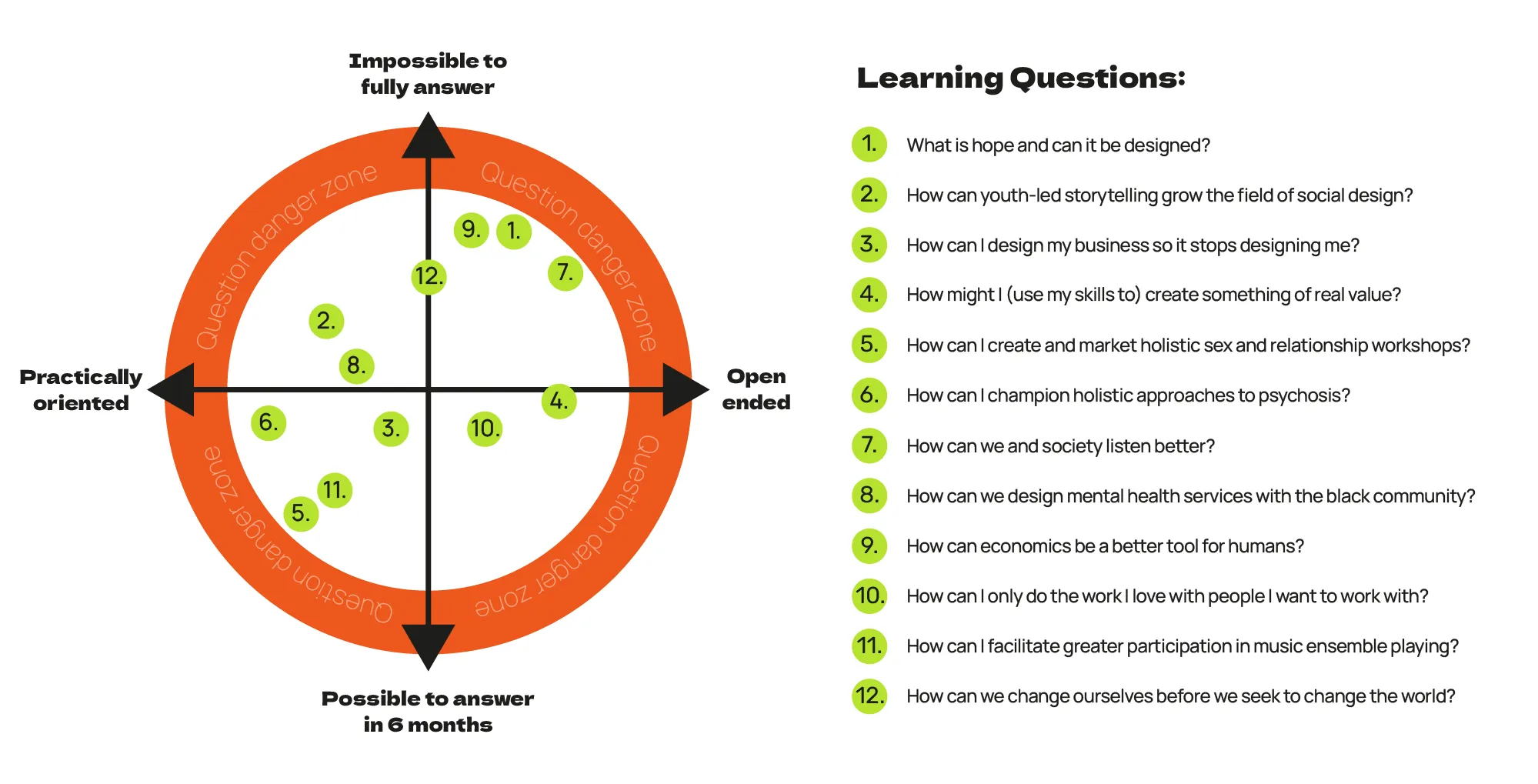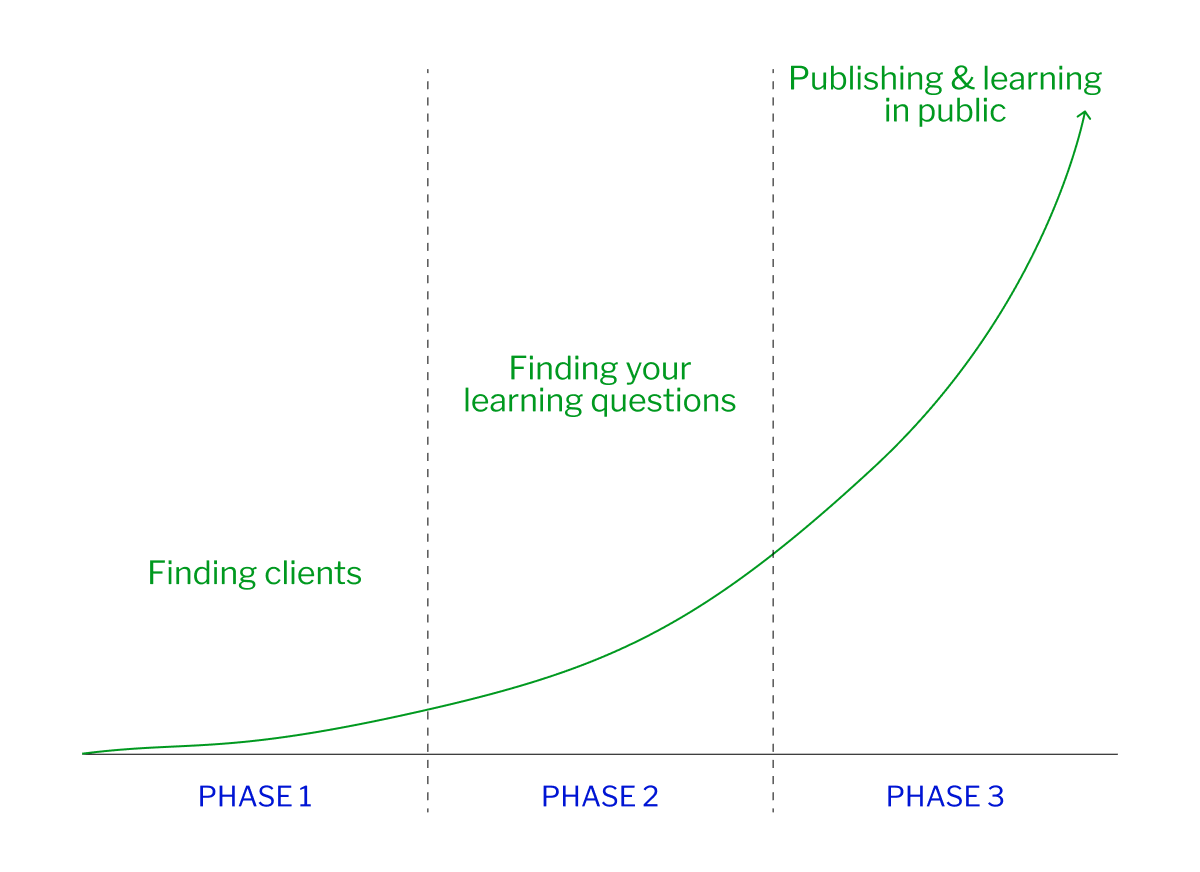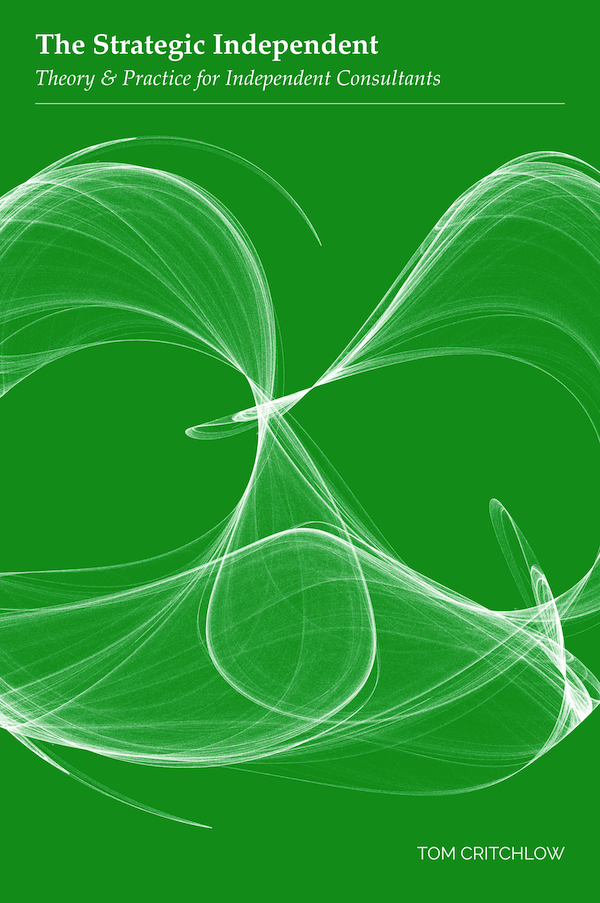Narrative Aircover & Compound Narrative
The narratives that nourish and sustain you as an independent consultant
“I read in a book once that a rose by any other name would smell as sweet, but I’ve never been able to believe it. I don’t believe a rose WOULD be as nice if it was called a thistle or a skunk cabbage.” ― L.M. Montgomery, Anne of Green Gables
The identity and labels you create for yourself as an independent consultant are tricky things. They’re not fixed but they sure do seem to carry some mystical weight. If we go around calling ourselves a UX designer one week and a storyteller in residence another week we’re going to suffer a kind of internal angst, or vertigo.
When you have a job - your work label is given to you. Anyone can go see it on your LinkedIn page. “Product manager at Salesforce” or “Head of marketing at Etsy”. These labels are very clearly defined - and they mean something - “product manager” and “head of marketing” are legible and transferable between companies, they convey a shared sense of knowledge, expertise, seniority, salary and more.
But when you step out on your own….

LinkedIn doesn’t know what to do with you. Freelance strategy consultant employed by tomcritchlow.com…? Sure I guess?
You might think this is a surface level problem - haha ok so LinkedIn doesn’t know how to deal with me. No biggie - LinkedIn is garbage anyway right.
Except… the power of labels isn’t for others, the power of labels is for ourselves.
Good labels give us the power to charge money, they give us confidence and energy. While bad labels can cause psychic anguish and self-sabotage.
When you step out on your own into the world of independence, you’re suddenly responsible for your own label. For the self employed indie consultant swapping out identities can be as easy as changing the words on LinkedIn or rewriting your landing page.
We’re simply not designed to switch our sense of identity so quickly or easily.
In part 1 we’ll look at choosing the labels you use - dealing with the disorienting and uncomfortable questions about who you believe you are, who we want to become and how much you believe your own bullshit.
In part 2 we’ll look at evolving and growing your sense of identity over time. Untethered from the world of pay rises, promotions and job titles, how do you create a sense of progress and personal growth?
Part 1: Narrative Aircover
A defining characteristic of the internet is to rewrite the rules of permission and institutions. This means that the way that identities are formed is changing too - how they are generated, shaped, validated and sustained all change because of the internet.
The old world is full of gatekeepers to impress - but the networked age radically changes the game. It changes who gets to give permission and which parts require permission at all. Now, in 2024, we’re firmly in an era of permissionless identities.
It’s no longer sufficient to rely on existing authority and institutions to create your labels - instead you need to create and tend to your own labels.
For independents you feel this acutely when you first step out on your own - how do you describe the work that you do? How do you describe who you are? But no matter the labels and language you choose, to begin with it’s going to be made up. You don’t yet have enough of a track record, client history or confidence in who you are or who you will become to state anything with certainty.
And in fact, this is a good thing! This leaping into the chaos of the unknown is one of the things that attracts weirdos, fools and generalists towards the independent lifestyle in the first place.
The first year or two of independent consulting are typically a swirling mixture of trying on labels for size. Are you a product manager? Consultant? Freelancer? Innovation designer? Copywriter? Strategist? Brand strategist? No-code guru?
These labels are going to swirl around you and I’m going to tell you that it’s ok to thrash around for a while - try labels on for size. Create new ones! Discard old ones! Come back to the ones you discarded before!
As Herminia Ibarra says in the wonderful book Working Identity, the dangerous thing is to clutch too tightly to a singular introspective idea of “Who am I?”. Instead Herminia suggests we should adopt a more iterative, playful idea of “who could I become?”:
“How do we move forward and reinvent ourselves when our very selves have been so shaken? For starters, we must reframe the questions, abandoning the conventional career-advice queries—“Who am I?”—in favor of more open-ended alternatives—“Among the many possible selves that I might become, which is most intriguing to me now? Which is easiest to test?” Getting started depends on whether we are looking to find our one true self or whether, instead, we are trying to test and evaluate possible alternatives.”
This process of becoming is entirely natural and in fact can be generative - leading to new ideas.
But this thrashing and cycling through labels can be psychologically exhausting too. For those around us - and for ourselves - how do we maintain some sense of stability in the chaos?
The answer is not to hide our consulting identity, but to protect it and give it some shelter while it’s still emerging. Enter narrative aircover.
Narrative Aircover
When I quit my last job almost 10 years ago, I didn’t know that I’d end up doing so much consulting work, or that I’d end up identifying so strongly with the label “independent consultant”.
It turns out when I quit my job I was actually trying to build an art startup with my partner: Fiercely Curious. You can see from this email exchange that Fiercely Curious is the primary label and identity I’m using:

It took about 9-12 months of juggling some consulting work and building an art startup to realize that:
- Consulting pays far better than building an art startup (who knew!)
- I actually enjoyed consulting
This was about the time that I decided to go “all in” on consulting, to start using that label and identify that way. Importantly by that stage I’d had 4-5 solid consulting projects and had some confidence that “consultant” meant something more than just “unemployed freelancer”.
This was all kind of accidental but in hindsight incredibly valuable - the ability to lean on Fiercely Curious as a project with some kind of substance allowed me to show up in the world, to have conversations with people, to network, to tell people what I was up to.
All while I muddled my way through becoming a consultant.
That’s why I call this “narrative aircover” because it provides shelter and protection to the emerging identity while it’s still incredibly fragile.
In my case, my narrative aircover was in the shape of an art business. In your case it could be an online food magazine, or a meetup event series, or a podcast.
The key thing for narrative aircover is that it’s expansive, passionate and unblocked.
I think the following characteristics are most useful for narrative aircover to provide you value in the early stages of starting a consulting business:
1. Expansive to grow your surface area
While our consulting identity is small and fragile it can be easy to close up - to adopt a stance of safety. “Who am I to talk about being a consultant, I barely have any clients!” or “What do I have to say on LinkedIn, I’m not even working right now!”.
But growing and nurturing your network is essential to building a long term sustainable indie consulting career so in the early days it’s important to do things that open you up - open you up to opportunities, connections, conversations and clients. So you need to pick something that’s expansive - something that opens you up to invite connection.
Example: When Vicky Gu went out as an independent brand and content strategist - she leaned on narrative aircover of her online food magazine Currant. There, she is able to describe herself as a “managing editor” (see how easy it is to award yourself labels in a permissionless world!).
Currant is expansive - it is a way in for Vicky to have conversations with chefs, restaurant owners, writers, designers and all sorts of other folks in the making of a digital publication. But it’s also expansive in the sense that through sharing editorial pieces about food, she can reach new audiences.
The idea that your narrative aircover is something that can invite people to lean in allows you to easily have new conversations with new people and expand your surface area. Whether it’s an email list, event series or non-profit.
You want a project that opens doors - something that gives you an excuse to be public, visible and interesting. Building something that is a permission tool to give yourself permission to reach out to people, to meet people for coffee, to connect and to build your network.
2. Passionate to show off your vibes
As we saw in Strange Attraction, the value of your network comes from all kinds of weird and wonderful places - it isn’t always the people you would expect. And as we saw in Rejecting Specialization to secure senior level projects you need to expose your vibes.
So it’s important to have something interesting that you can talk about. My art startup is a great conversation starter - a lot of people are interested in art and culture. Just like lots of people are interested in Vicky’s food magazine.
Launching a narrative aircover project that is inherently aligned with your passions will help ensure that people are paying attention, leaning in and taking your meetings.
3. Unblocked so it’s within your control
Finally, you want your narrative aircover project to be more under your own control than consulting work. One of the primary problems to solve is that you likely don’t currently have a lot of consulting work to rely on or talk about - you’re dependent on clients to move things forward.
So you want your narrative aircover project to be alive by default - not blocked and relying on others to move forward but something that you can move forward under your own steam. Even a humble blog can fit the requirements here - free to publish as and when you want without any kind of gatekeepers or dependencies on others.
In summary - indie consultants are creatures of momentum and narrative aircover is how you get started. It’s about creating activation energy in your network to start making something happen - because without that you’re going to just sit there and worry about finding clients.
Narrative aircover isn’t about hiding our consulting identity - it’s about not leaning on it too hard during the early days when it’s most fragile and still evolving.
Narrative aircover provides you meaning, labels, safety and permission to engage with people while you’re figuring things out during the first year or so of your journey.
Part 2: Compound Narrative
Eventually, at some point down the road you will successfully manage to generate revenue, find clients and build a consulting practice that works - your next problem is figuring out how to make it sustainable.
Understandably - so much of your focus in the first few years of setting up your practice is on consistently generating clients. That is after all the most important thing you need. One client after another. Line em up.
But at some point you can end up stuck - feeling like every client is simply another spin of the hamster wheel. Trapped in your own constraints of client work you’re feeling like there’s a never-ending series of client projects on the treadmill. A feeling that every client is starting from zero again.

One of the biggest downsides of consulting is that there’s nothing passive about the revenue - nothing compounds. To pay rent each month you have to keep generating clients.
This is why, once you reach some stability with consistently generating clients and revenue, many indie consultants begin to think about “scaling themselves” - either in the form of hiring staff or in building “passive income” products.
This reflex isn’t bad per se but it’s important to recognize that they are avoiding the real problem. They are avoidance of dealing with the root issue of actually enjoying your consulting work. Of finding a way to value and enjoy client work over long periods of time.
Some of the things we’ve talked about in the book can help you enjoy your work: shifting to strategic clients helps keep the work interesting and focusing on being impactful helps the work feel meaningful. But at some point it can start to feel like a grind.
The problem is that outside of the constraints and norms of full time work, a defined career and job progression - there’s no simple measure for professional advancement.
No one is paying for training, no one is sending you to conferences. No one is giving you a promotion or a new job title.
So you have to find your own personal growth plan - a way to both find intrinsic meaning in growth and development and in externally visible progress towards being “more senior” and able to move upwards inside client organizations. Otherwise you’ll stagnate, your earnings will plateau and your public image will stall out.
Fitting every client into a narrative frame
The trick here is to use each client as a compound build on the last one, not simply another go around the treadmill.
Example: In my own work - in year 2, after finding some routine in generating clients and steady work - a friend asked for advice on going out on their own, so I wrote up a blog post with some thoughts. That blog post generated a few more blog posts about the practice of independent consulting and before you know it I was writing this book (a project that would creatively sustain me with compound narrative for the next 6+ years!)
The trick is that every new client isn’t simply a chance to do the same thing but it’s a chance to deepen my perspective and experience on the practice of independent consulting. Every client can teach you something.
Now I gleefully look forward to new clients because I know they can become stories and examples for my book project.
I call this idea compound narrative. You need some way to feel like every client builds on the last one - that you’re left starting from somewhere new, not starting from the same place every time.
Then - the trick is to view every single client, no matter how “boring” or “routine” or “straightforward” on the surface - as being part of that compound narrative. What insights or evidence can you gather towards your questions through this client project?
Niko Canner calls this “mastery of a larger game”:
The medium to do this larger work was in writing. In my prior chapter as a founder, building Katzenbach Partners, I’d never given myself much space to write, because that had never felt as important to my goals as the work of entrepreneurial leadership, rainmaking and advising clients. I needed to change that, and to recognize that writing would be my vehicle for reaching toward greater mastery of a larger game. Writing wasn’t in service of building an audience or building a business. Writing as a learning practice was an end in itself.
This might seem straightforward but the subtle trick is choosing a narrative frame that you’re actually interested in. For example, if you’re a digital PR consultant - the obvious learning frame for your work would be to learn about the practice of digital PR. Sure, this makes sense - except perhaps you’re not really interested in the idea of “digital PR” - it’s too broad and doesn’t have any kind of hook to it.
The trick is to find a frame that lights up your curiosity - perhaps something like “how digital PR is evolving as new social platforms emerge” or “how companies measure the effectiveness of digital PR” or “why digital PR doesn’t get a seat at the executive table”.
Finding the Right Learning Questions
Notice that these narrative frames are all open ended questions that possess a measure of specific curiosity. These narrative frames can be far more interesting by virtue of being more specific.
Questions are powerful tools for shaping your thinking and perspective. Finding good questions can sustain and nourish your curiosity and help you feel alive. They’re the antidote to burnout and stagnation.
But how do you find good questions?
A great place to start is to write down a list of questions that you don’t know the answer to. Questions that might not even have an easy answer. Questions that you can explore over an extended period of time.
The community Huddlecraft calls these learning questions:
It’s important that a Learning Question be open. Open questions are ‘designed to encourage a full and meaningful answer using the subject’s own knowledge and/or feelings’. They are the opposite of closed questions which encourage single-word answers.
Similarly, a Learning Question is designed to encourage a full and meaningful enquiry. It’s more about provoking a process of learning than about finding an answer, but if you do seek an answer it must be one that incorporates your growing knowledge and personal perspective.
Very often a Learning Question spawns a series of new questions which continue to move you forward and help you grow. Unlike an academic thesis question a Learning Question does not seek resolution as an enormous written paper! It seeks a creative response appropriate to the question.
And they have this lovely 2x2 framework with examples of learning questions:

This 2x2 framework feels right - if you write down 10 ideas for learning questions, you’ll be able to plot them (subjectively) on this 2x2 graph. It’s not that every single learning question needs to be impossible to answer and open ended, but those questions are going to be the ones with the most potential to nourish and sustain your practice for the longest.
Example: Behzod Sirjani is an independent consultant with a deep background in user research. To sustain his practice he has been researching and publishing OAE - a learning question around organizations as ecosystems:
“Organizations as Ecosystems” is a research and writing project about the ways that organizations sense, react, learn, and change. Some outputs of this project will be regular essays and a corresponding set of readings and references.
This is a perfect open ended and impossible to fully answer. It’s easy to see how this question could sustain years of client work, where each client is an opportunity to explore and deepen your understanding of the question of how companies sense, react, learn and change.
Finding the right set of learning questions is incredibly powerful because it turns your consulting practice into a sustainable practice. It enables you to stay in the work for long multi-year periods. Because you have to stay in the work - if you’re an independent consultant there’s no one to do the work for you - no employees, no colleagues to lean on. So you have to stay in the work.
Compound Thinking & Publishing
The magical thing about finding questions you’re interested in and pursuing them for a while is that you end up with interesting things to say.
As you deepen your understanding of the questions you’re interested in you find that these projects turn into generative and useful objects
For example, here’s John V Willshire back in 2015 talking about the famous “Smithery Projects” that he embarks on each year:
“Ah, the famous annual Smithery projects. Well, famous might be pushing it, let’s go with ‘the thing that we do at the start of each year’. 2012 was about Making, 2013 was about Media, and 2014 was about Playing With Ideas, which in hindsight remained gloriously ill-defined but gave rise to August’s Culture Matrix malarkey, so we’ll let it off.”
One of those projects eventually turned into a delightful foundational framework and approach called Zenko mapping that is core to how Smithery operates.
It’s part of why publishing is such a rich pursuit for indie consultants - it’s a culmination and focus on the act of accumulated insights. Turning your compound narrative into a published artefact is incredibly powerful - it positions you as an expert, builds an audience and is incredibly satisfying!
There’s a rich vein of self-publishing by indie consultants:
- The ux consultant writing a book about UX design.
- The designer writing a book about design.
- The security consultant publishing emergency extraction guides.
- The ethnographic researcher publishing the fieldguide to ethnographic research.
- The indie consultant publishing the book about independent consulting (coming soon!)
But it doesn’t have to be a book - publishing in all its forms can be an email newsletter, it can be a podcast, it can be a zine, it can be a research report.
Any of these can work and in fact the ongoing nature of something like a podcast can help sustain an interest by becoming a vehicle not for promoting, but for learning! For continually being interested in the work you’re doing.

And if you do it all correctly, the sky’s the limit as April Dunford, author of Obviously Awesome, will testify:
“Getting the book out was absolutely transformational to the business. Like, that’s what took me from, this is a good business that pays me more than what my salary was in house, you know, yay me, consultant, to holy man. I didn’t even think it was possible to make this kind of money and work with this kind of clients and do this amazing stuff. And, yeah, the book was a game changer.”
In Summary
The challenge of managing your own identity - free from any constraints and expectations of full time work - can be a surprising challenge. Realizing that you can be whoever you want to be comes with a sense of being untethered. Navigating that narrative journey requires anchoring ourselves to things - whether it’s narrative aircover of a self-directed project or the compound narrative of learning questions.
And eventually, once you find a generative set of questions to explore, it can sustain an independent consulting practice for years - helping you generate interesting clients, enjoy every new client and build a sense of personal growth and progression.

